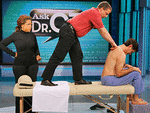
Neck
The neck is a highly functional part of your body, being continually in use. The neck holds up your head and the neck muscles are constantly called upon as you do simple daily tasks like driving or using your neck to turn your head. A common irritant for many is a stiff neck. However, not all stiff necks are the same. While most of the time a stiff neck is caused by whiplash, ergonomics, wear and tear, or even just sleeping in a funny position, there are rare instances where it can be the sign of something systemic. Most of these causes of a stiff neck boil down to quite simply poor posture supporting the neck.
The Rolf Approach To Stiff Necks
Rolfing is one of the best ways to improve posture, rooted in its cohesive understanding of the term itself. As a result of the common interpretation posture as one of holding a static, “correct” postural position, many people lose the natural flexibility and the natural posture of their bodies. Its positions like these that can lead to stiff necks.
Rolfing on the other hand continuously seeks out a dynamic, creative balance in your body that is quite different from holding it in one rigid postural position that cannot easily accomodate the daily demands of life. Posture, as taught through Rolfing, is a creative, fluid process. With Rolfing, you move with correct posture, you do not hold. Rolfing will re-establish inherent balance to your properly aligned structure and how to let gravity do the work of providing support. This ultimately improves posture. To understand how Rolfing treatment for the neck works, it is important to recognize that the neck injury cannot be understood by looking at the neck alone. The shoulder and neck rests on the thoracic/cervical spine, and hence these two interconnected segments must be treated together. The neck and back are also part of the same structure.
How Rolfing Treats Stiff Necks
The Rolfer® slowly uses his hands to release adhesions, strains and sprains in the fascia of the neck. The fascia is the fibrous web of connective tissue which binds muscles, bones and organs together. The relative flexibility of connective tissues determines how easily muscles will move, therefore the Rolfer® will work on the connective tissue to help free the muscles, and thus releasing the chronic pain in the neck.
Rolfing’s great strength is that it is non-invasive, and hence while undergoing Rolfing you will be able to continue with daily life and even sports, while simultaneously treating and relaxing your neck muscles, which will eventually allow you a greater range of movement of the neck and increase your flexibility.
It is crucial to understand that Rolfing will treat the body not as individual parts, but as a whole, so the whole organism realigns. Then, movement education would be provided to help prevent future recurrence of the problem.
neck
|

Certified Rolfer®
Vincent Lee
Rolfing was featured in


“Two Hands” 2007 Academy Award. Nominated for documentary film.

Andrew Weil, M.D.
“Good Morning From Dr. Weil.com” An on-line daily newsletter published a health news brief June 25, 2004--“Tip: Is Your Posture Bad? Today’s Tip-Rolfing."
